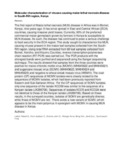| dc.contributor.author | Leitich, Robert K. | |
| dc.contributor.author | Korir, Jackson C. | |
| dc.contributor.author | Muoma, John O. | |
| dc.contributor.author | Wangai, Anne | |
| dc.contributor.author | Bong, Kim | |
| dc.contributor.author | Johal, Guri | |
| dc.contributor.author | Sue, Loesch-Fries | |
| dc.date.accessioned | 2021-12-31T08:17:00Z | |
| dc.date.available | 2021-12-31T08:17:00Z | |
| dc.date.issued | 202-07-31 | |
| dc.identifier.govdoc | https://academicjournals.org/journal/IJGMB/article-abstract/B73F9F764884 | |
| dc.identifier.uri | https://doi.org/10.5897/IJGMB2020.0199 | |
| dc.identifier.uri | http://ir-library.mmust.ac.ke:8080/xmlui/handle/123456789/1930 | |
| dc.description.abstract | The first report of Maize lethal necrosis (MLN) disease in Africa was in Bomet, Kenya, nine years ago. It has since spread in East and Central African (ECA) countries, causing massive yield losses. Currently, 90% of the preferred commercial maize germplasm grown by farmers in Kenya is susceptible to MLN disease. As such, the disease has continued to pose a serious challenge to food security in the ECA region. This study sought to characterize the MLN, causing viruses present in the maize leaf samples collected from the South-Rift region. Using total RNA extracted from 60 leaf samples collected from Bomet, Kericho, and Kisumu Counties, reverse transcription-polymerase chain reaction (RT-PCR) was carried out. The PCR products with the strongest bands were purified and sequenced using the Sanger sequencing technique. The results showed that samples from the three counties were positive for maize chlorotic mottle virus (MCMV) (MH645622 and MH645621) and sugarcane mosaic virus (SCMV) (MH645623, MH645624 and MH645625) and negative to wheat streak mosaic virus (WSMV). The coat protein (CP) sequences of MCMV isolates were closely related to the sequences of MCMV isolates, which had been previously reported from Eastern and Sub-Saharan Africa. For the CP sequences of SCMV isolates, only one sequence of the isolate KCO59 was similar to the sequence of a Kenyan isolate (JX286708). Sequences of isolates KCO5 and KCO24 were not identical to those of the Kenyan isolate (JX286708). Based on these results, in the surveyed counties, isolates of SCMV are genetically diverse, while those of MCMV are not. There exists a new variant of SCMV, which appears to be the main potyvirus in synergism with MCMV in causing MLN disease in Kenya. | en_US |
| dc.language.iso | en | en_US |
| dc.publisher | International Journal of Genetics and Molecular Biology | en_US |
| dc.subject | Molecular, characterization, viruses, causing, maize, lethal, necrosis, disease | en_US |
| dc.title | Molecular characterization of viruses causing maize lethal necrosis disease in South-Rift region, Kenya | en_US |
| dc.type | Article | en_US |

